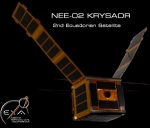Displaying items by tag: Ecuador
NEE-01 Pegaso
NEE-01 Pegaso is an Ecuadorian technology demonstration satellite, and Ecuador's first satellite launched to space.
Built by the Ecuadorian Civilian Space Agency (EXA), it is a nanosatellite of the single-unit CubeSat class. The spacecraft's instruments include a dual visible and infrared camera which allows the spacecraft to take pictures and transmit live video from space.
The satellite operated normally until 23 May 2013 wnen there was a collison with a debris cloud. After the incident, the satellite was found to be "spinning wildly over two of its axes" and unable to communicate with its ground station. While efforts were made to reestablish control of Pegaso, on 28 August 2013 the decision was made by EXA and the Ecuadorian government to declare the satellite as lost.
NEE satellite constellation
First and second Ecuadorian satellites
- NEE-01 Pegaso was the first Ecuadorian satellite.
- NEE-02 Krysaor was the second Ecuadorian satellite.
NEE-02 Krysaor satellite
The NEE-02 KRYSAOR is a PEGASUS class satelliite, of the Ecuadorian Civilian Space Agency (EXA), which means that is a twin of the original NEE-01 PEGASUS.
The NEE-02 will be launched in to a 98.7 degree inclination, helio synchronous orbit, 720km perigee and 890km apogee on November 21, 2013
Its mission is the same as PEGASUS, serving education and also acting as orbital sentinels watching for possible threats from small NEOs in last phase of atmospheric entry and helping to catalog orbital debris. Also it has the latest advances in active deployment of its solar arrays, high speed digital transmission and a higher resolution video camera.
NEE-01 Pegasus was an Ecuadorian technology demonstration satellite, and Ecuador's first satellite to be launched to space. Built by the Ecuadorian Civilian Space Agency (EXA), it was a nanosatellite of the single-unit CubeSat class. The spacecraft's instruments included a dual visible and infrared camera which allowed the spacecraft to take pictures and transmit live video from space. The satellite operated normally until 23 May 2013 at approximately 05:38 UTC, Pegaso passed very close to the spent upper stage of a 1985 Tsyklon-3 rocket over the Indian Ocean. While there was no direct collision between the satellite and upper stage, Pegaso is believed to have suffered a "glancing blow" after passing through a debris cloud around the Tsyklon stage and striking one of the small pieces. After the incident, the satellite was found to be "spinning wildly over two of its axes" and unable to communicate with its ground station. While efforts were made to reestablish control of Pegaso, on 28 August 2013 the decision was made by EXA and the Ecuadorian government to declare the satellite as lost.
Ecuadorian Civilian Space Agency (EXA)
The Ecuadorian Civilian Space Agency (EXA) is the organisation in charge of administering and executing the Ecuadorian civilian space program and conducting scientific research on space and planetary sciences.
It is a non-profit NGO with 100% civilian operation capital through private funding and self-sustained. It was established on November 1, 2007 and includes the first Ecuadorian trained astronaut, Ronnie Nader, among its staff members.




